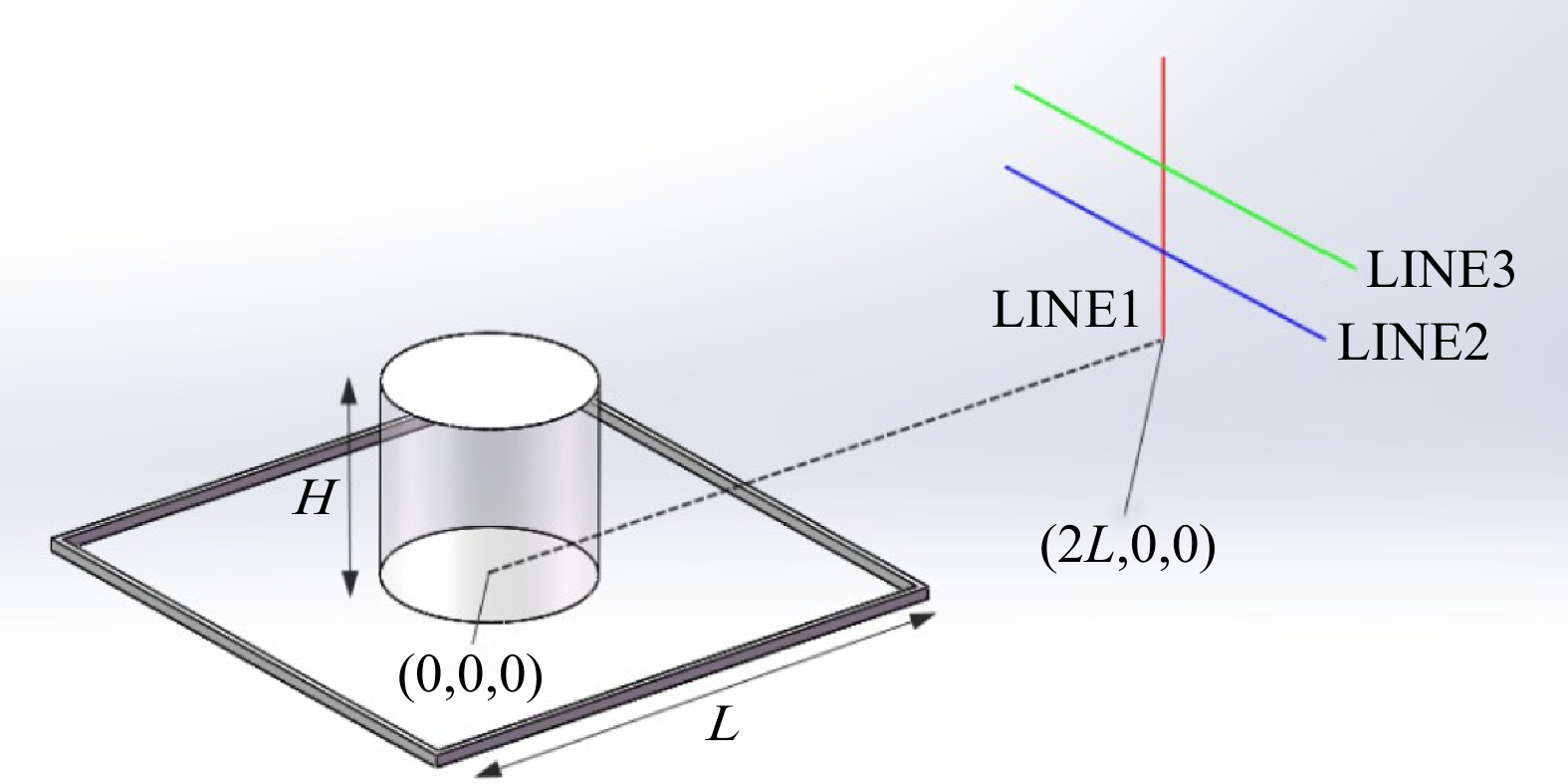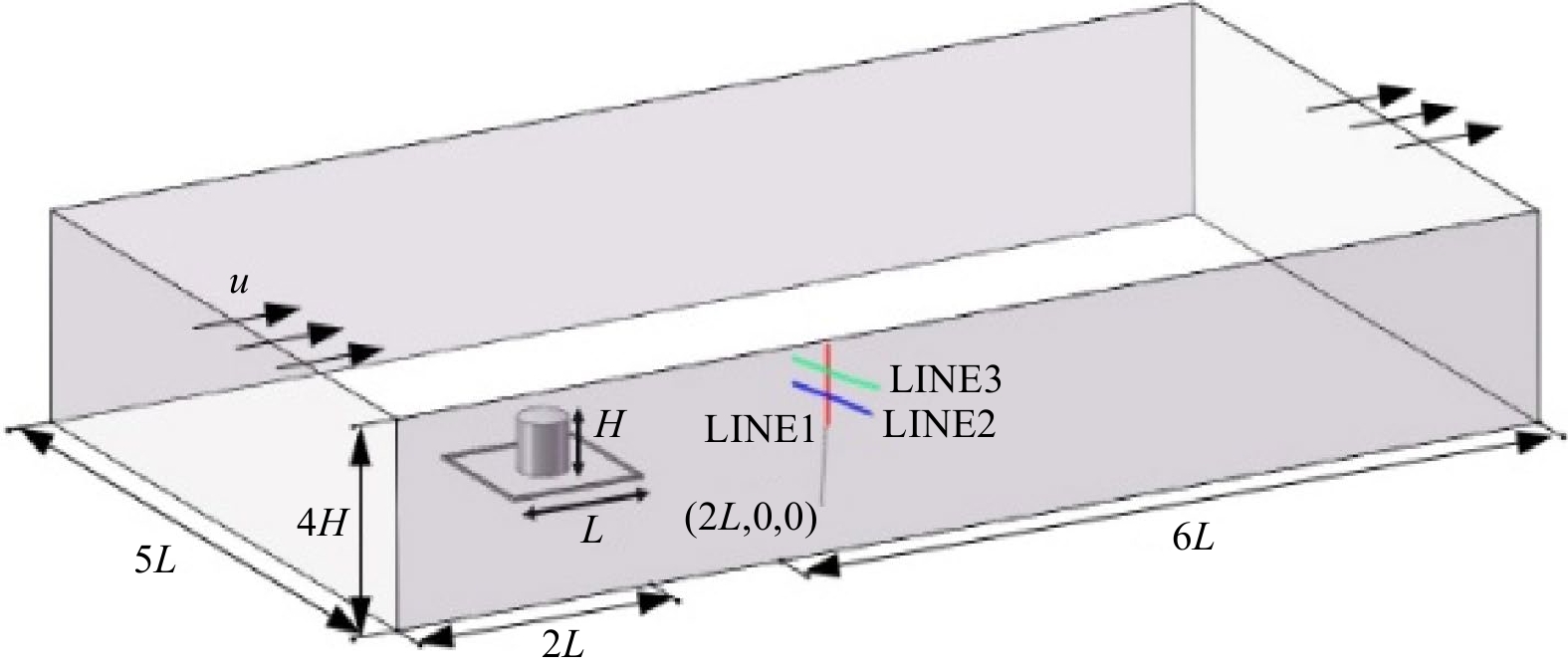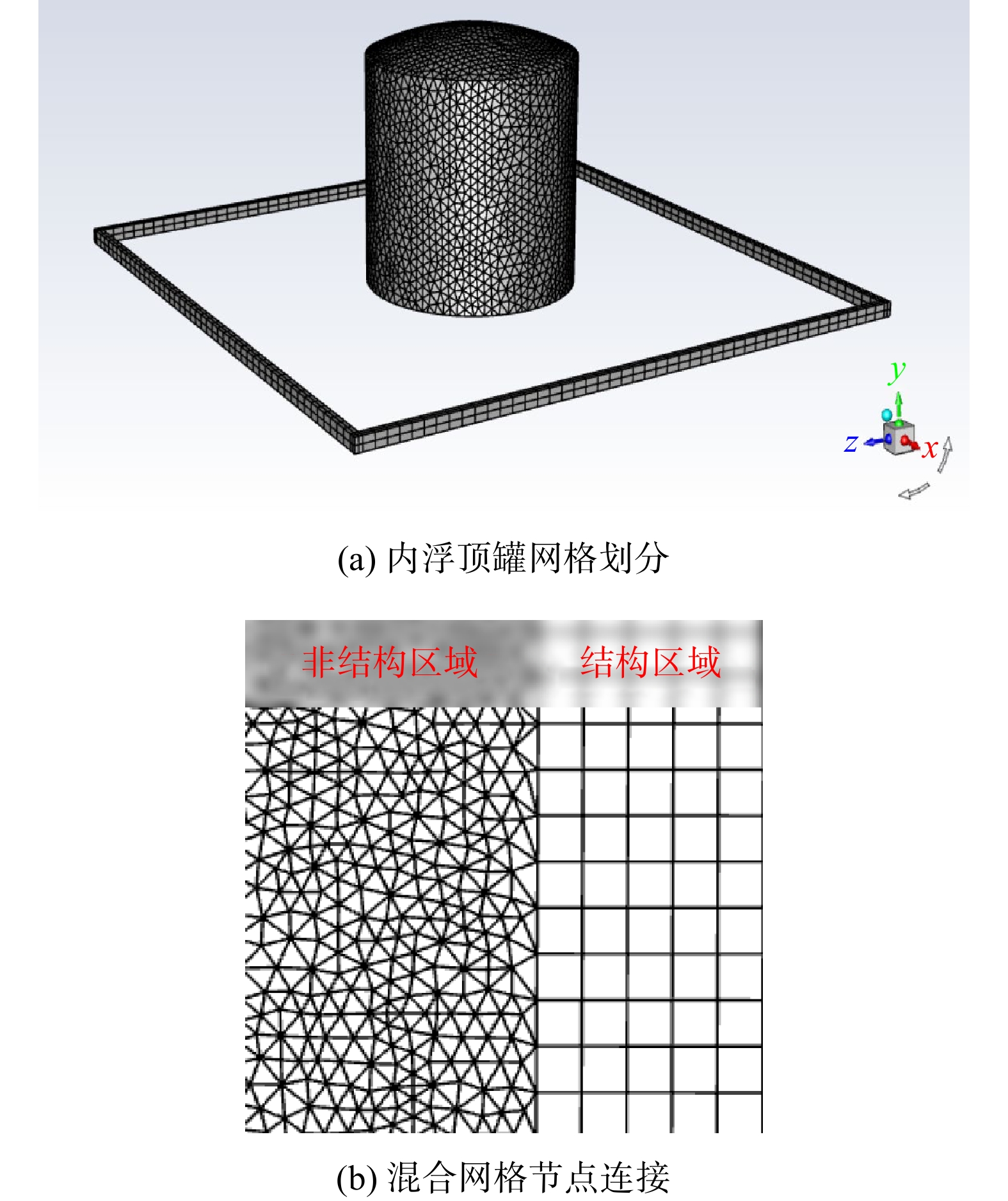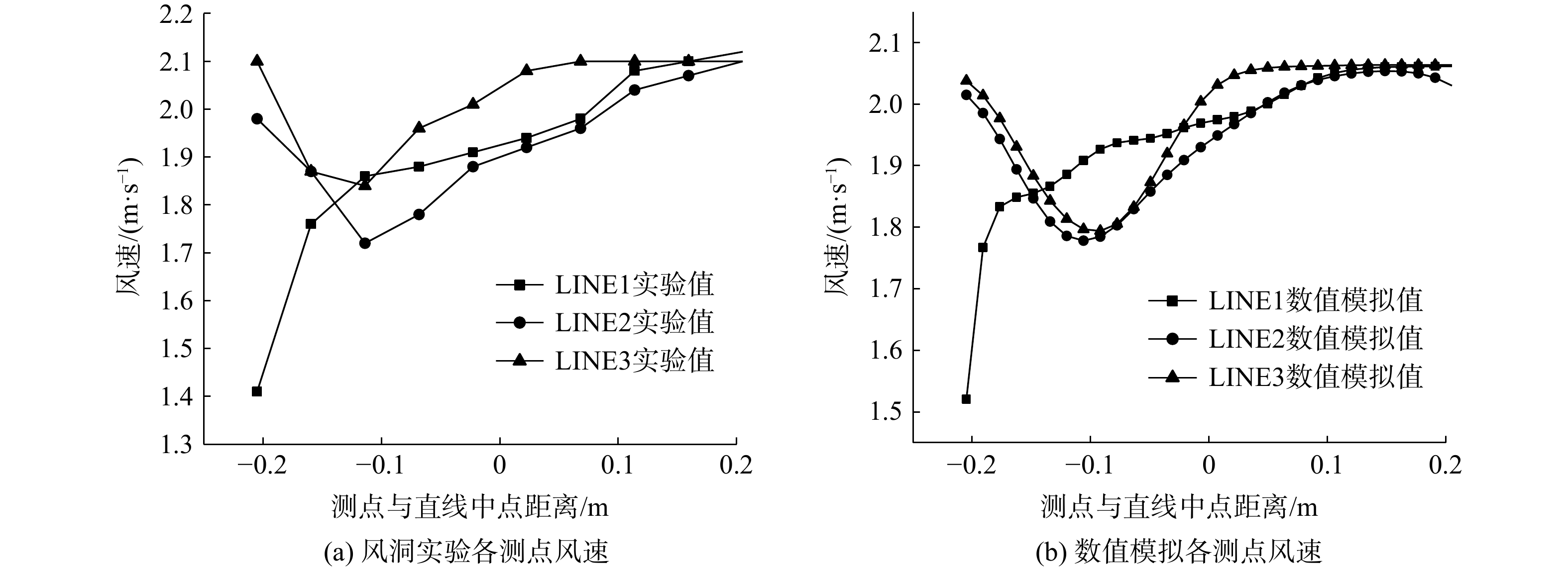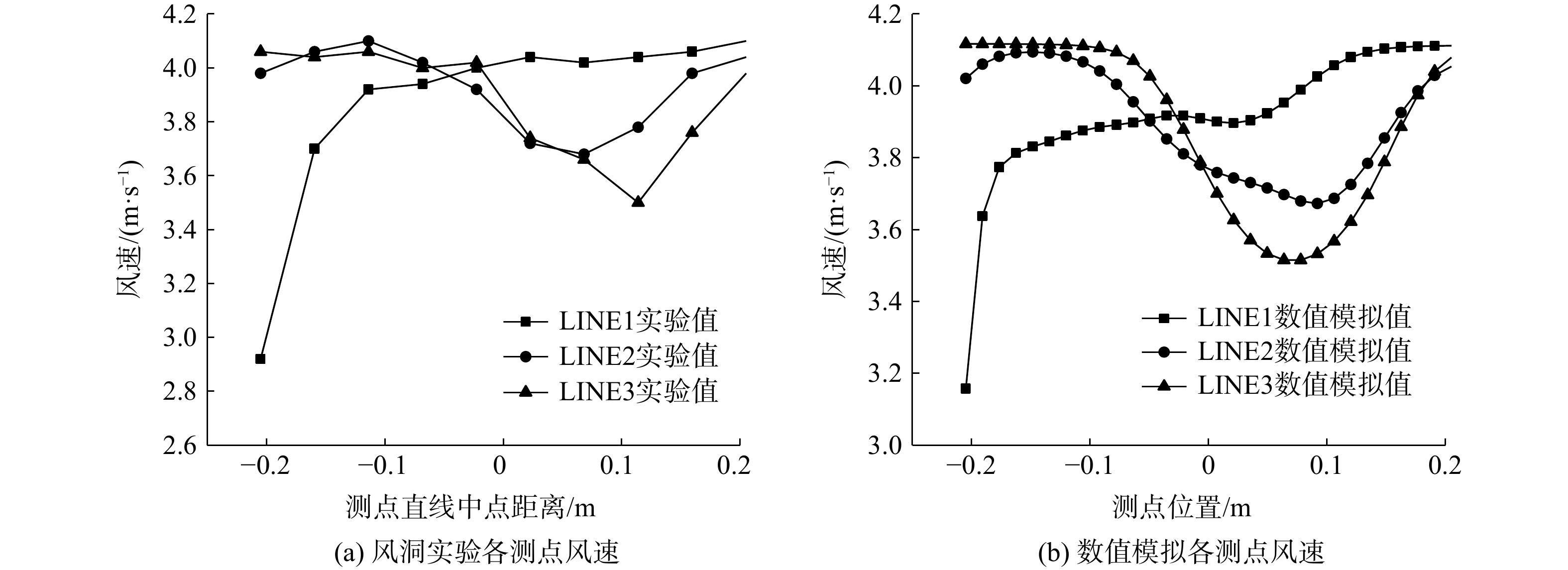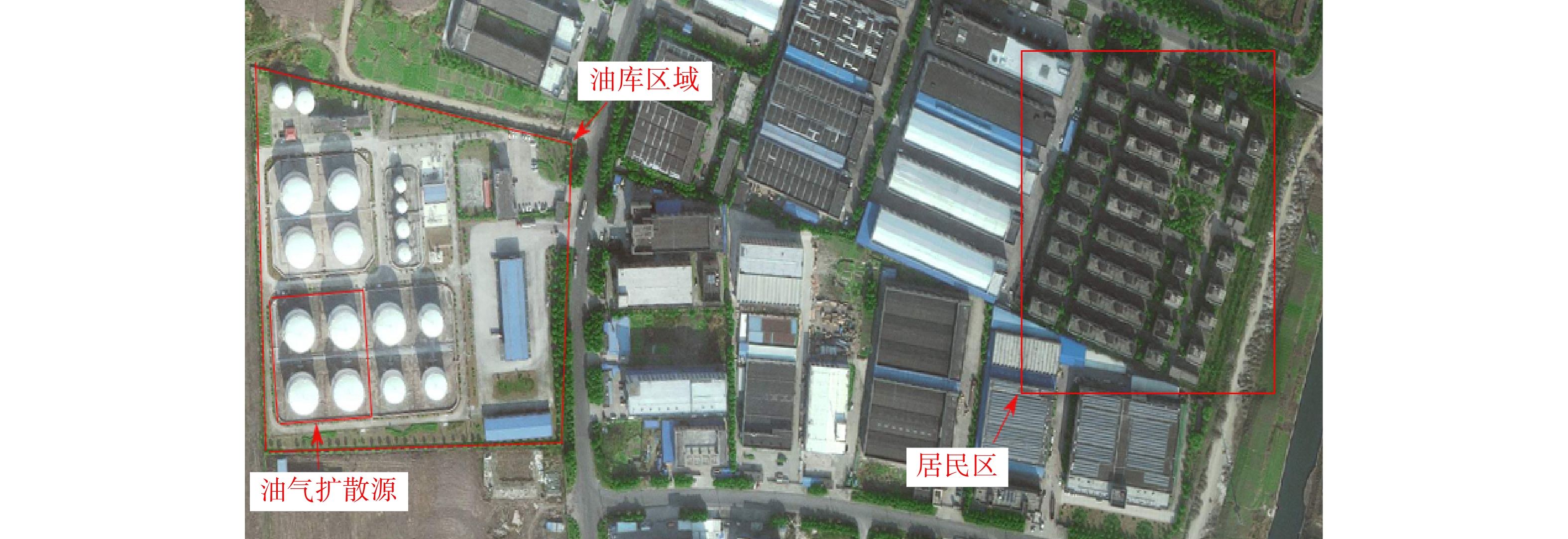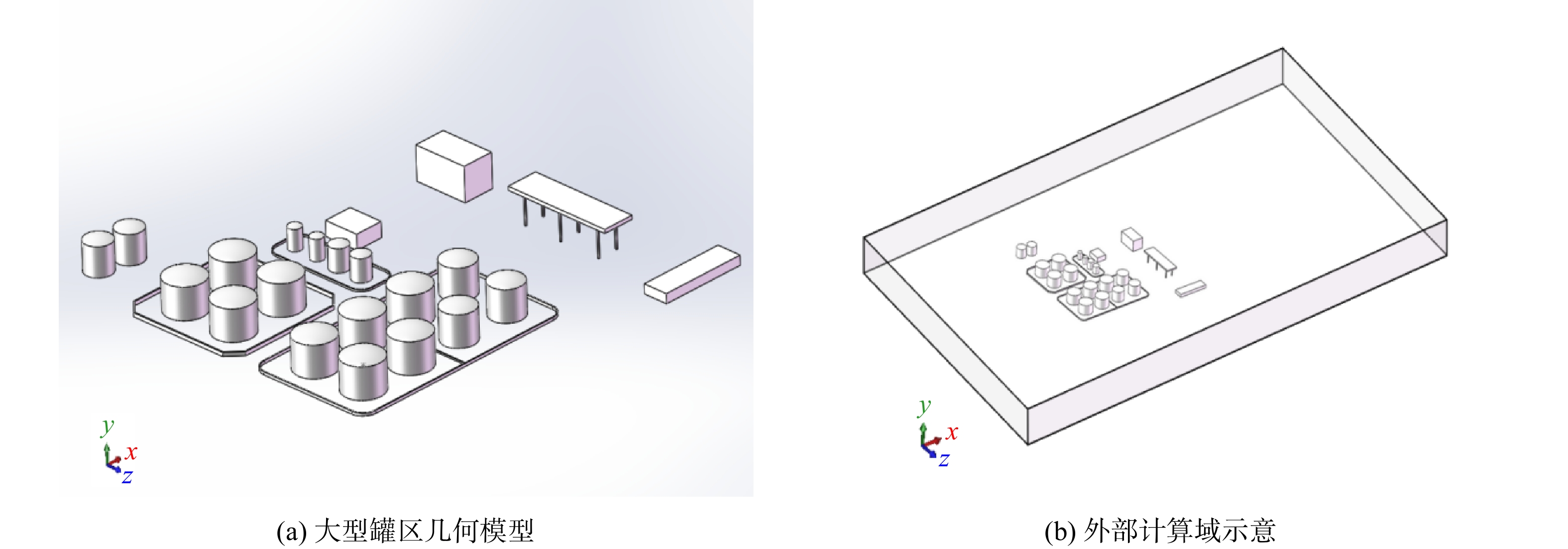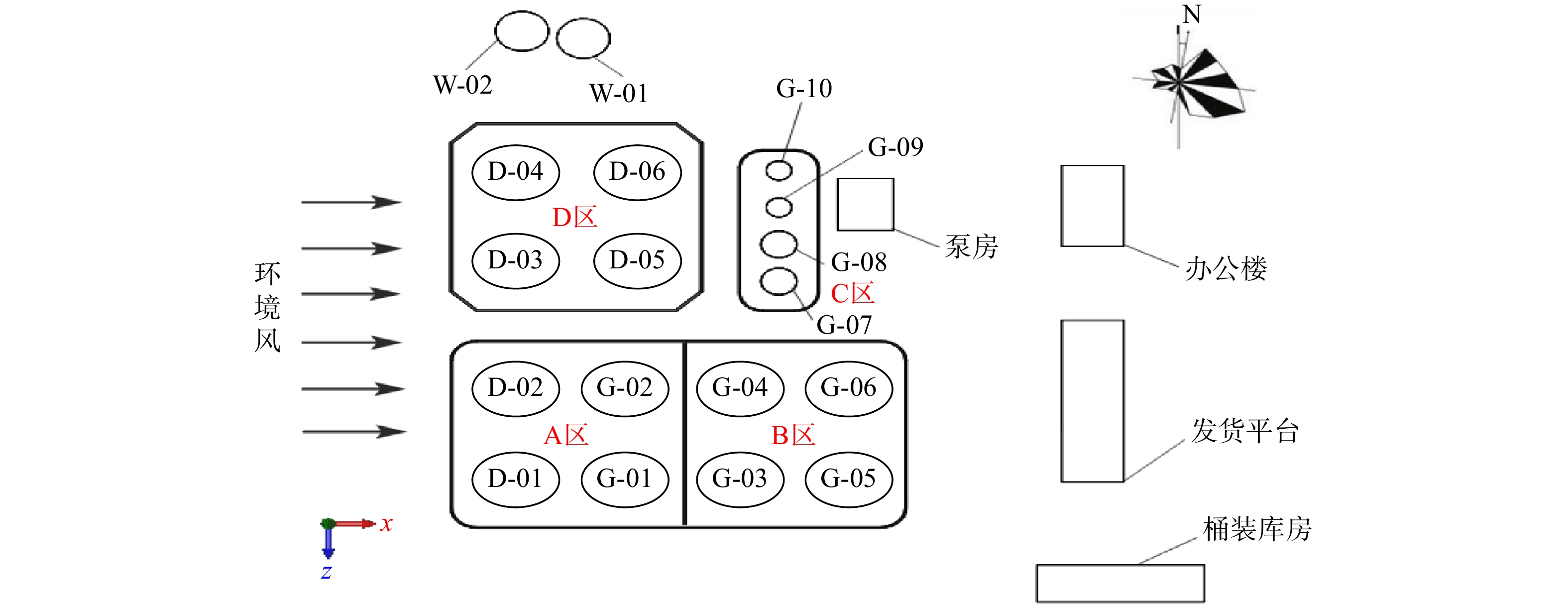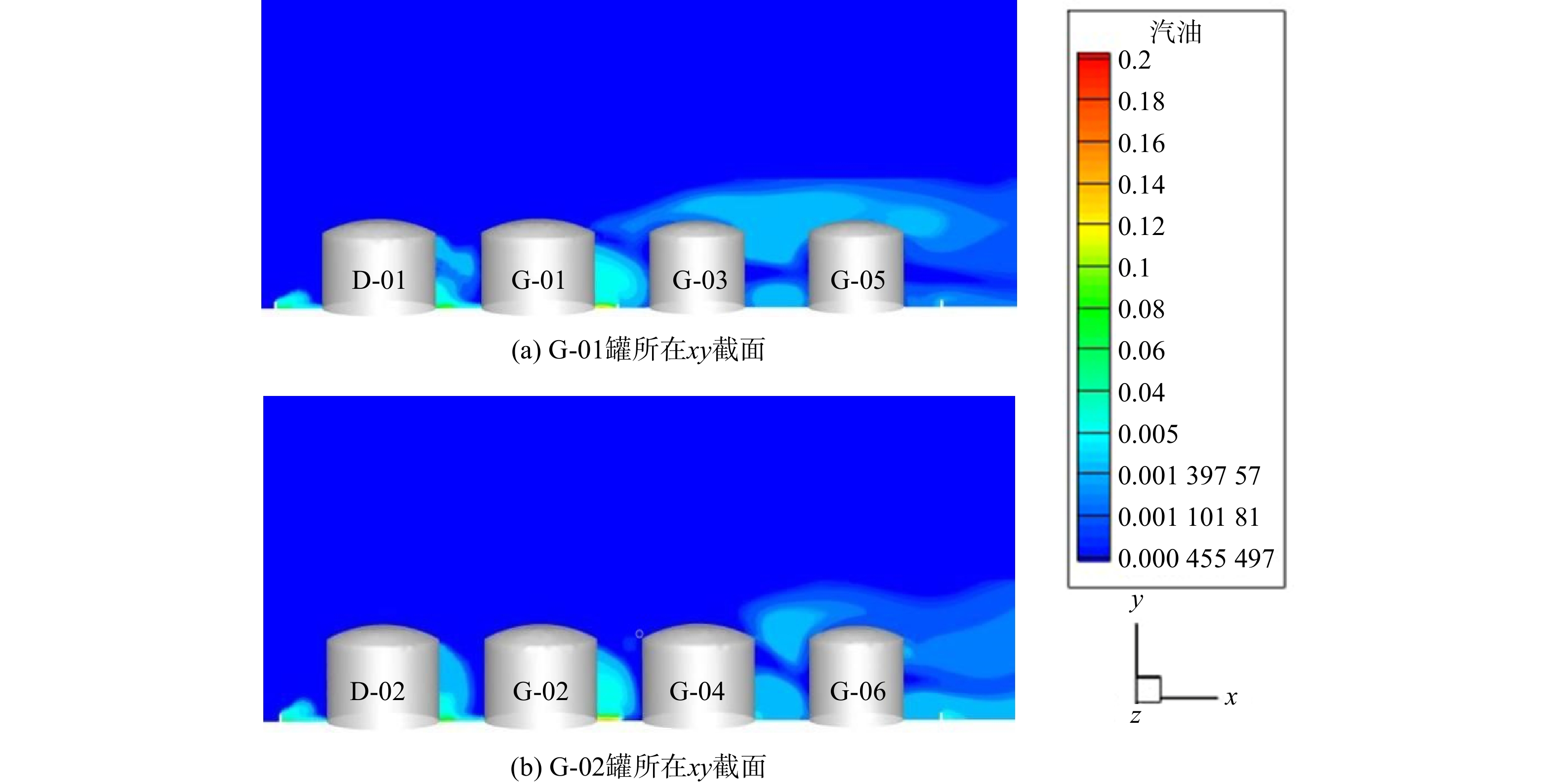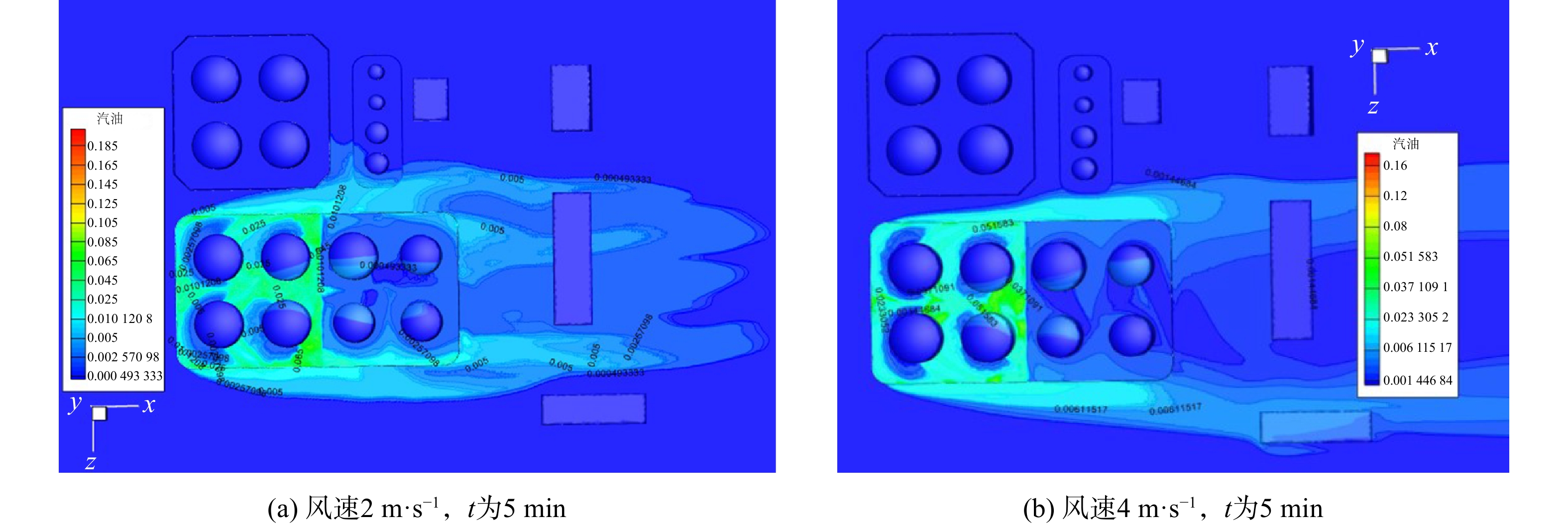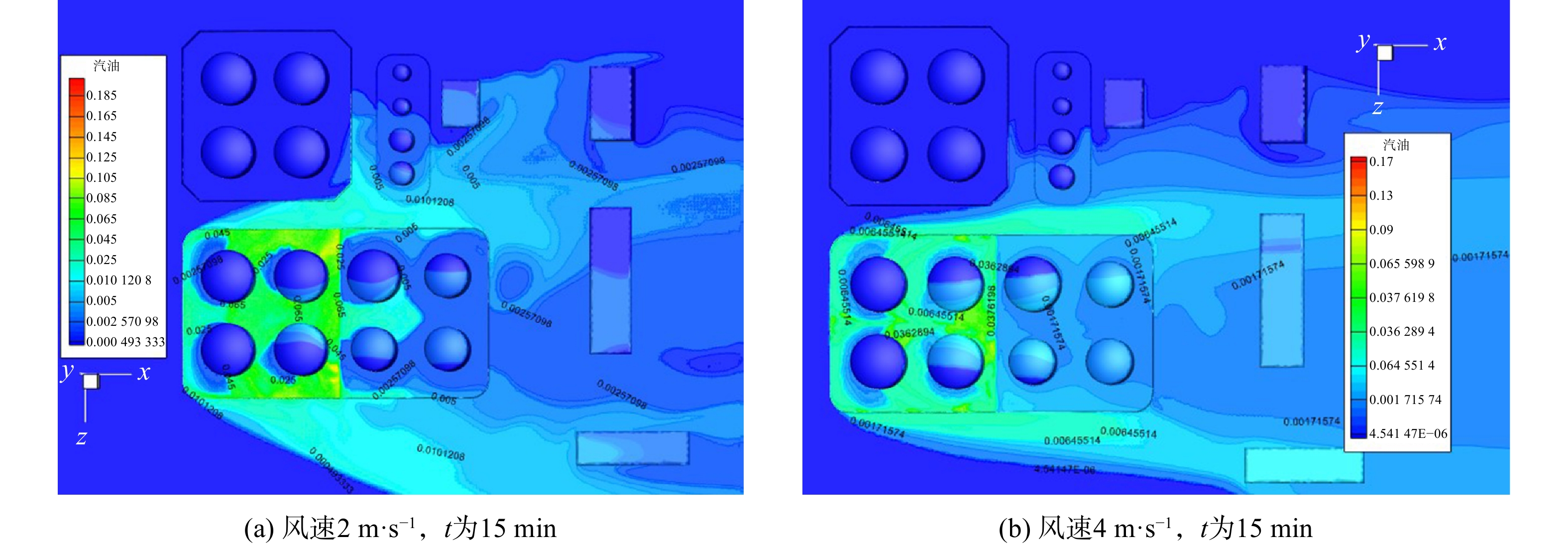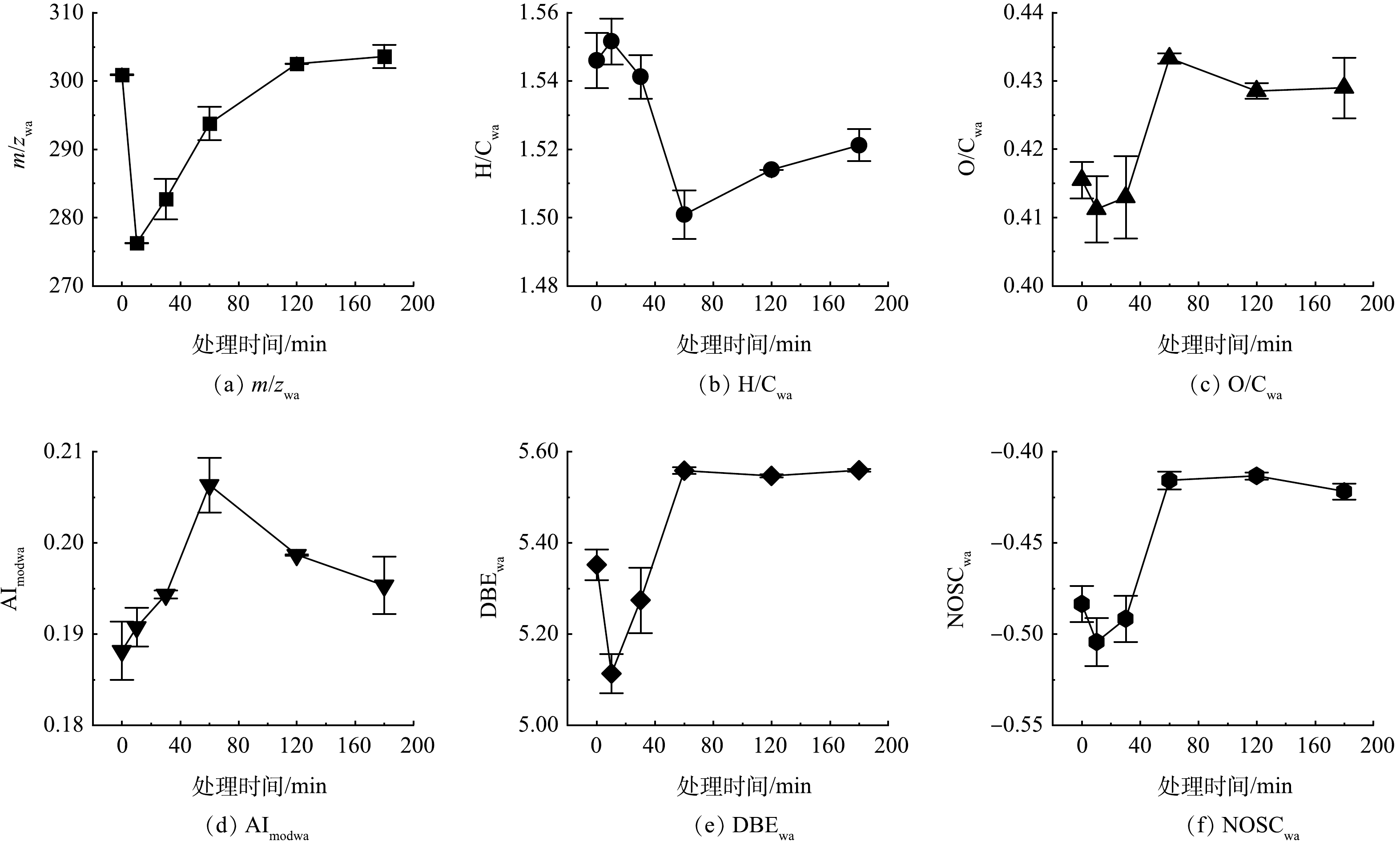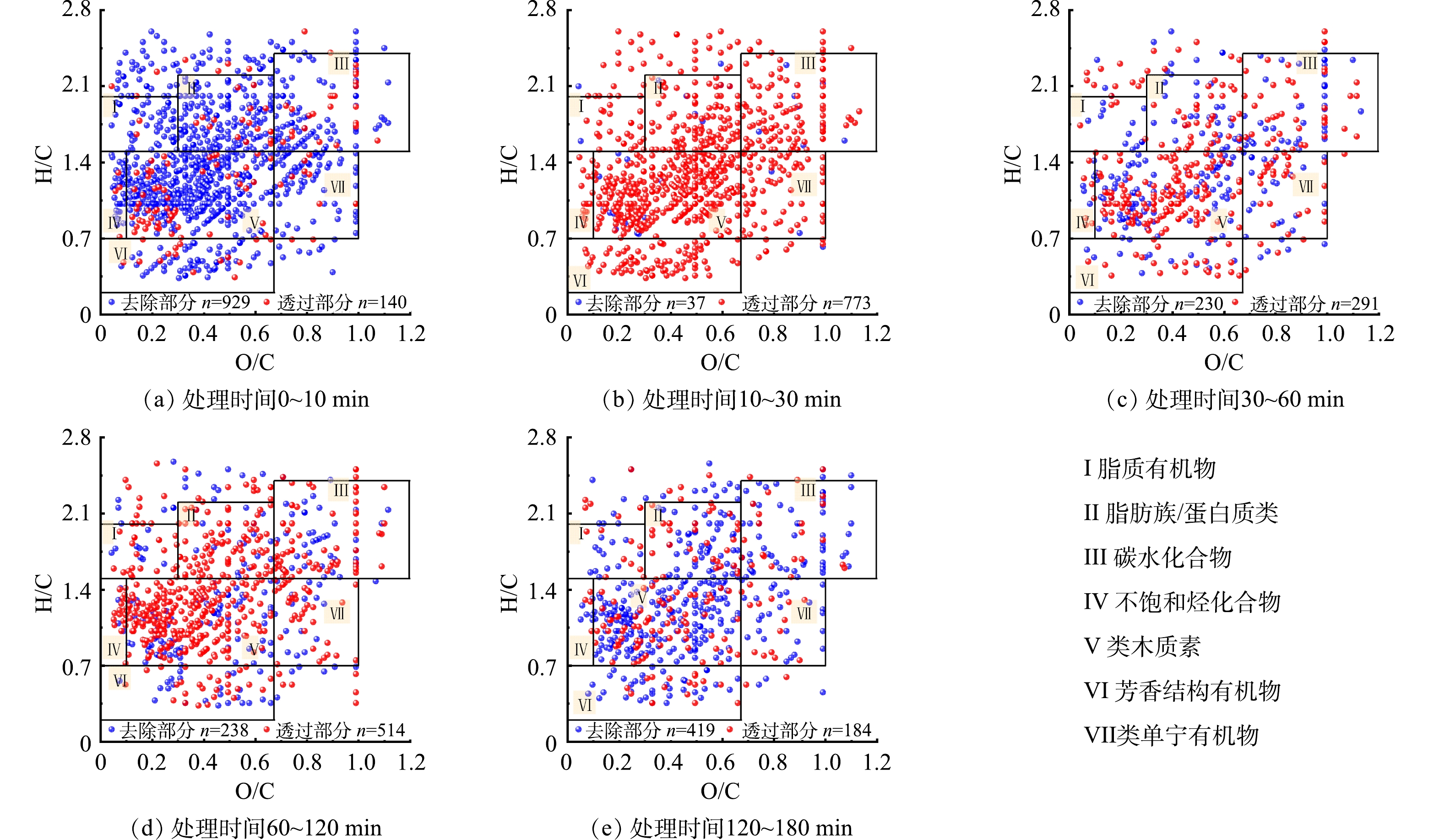-
海上船舶运输业已成为全球化趋势下的主要运载方式。船舶,特别是原油运输船在航运过程中会产生大量的含油废水,包括舱底水、压载水以及机械清洗时产生的洗舱水等[1]。此类含油废水成分复杂多样,具有含盐量高、有机物浓度高、水质水量变化大等特点[2]。船舶含油废水是一种典型的难去除废水,传统的处理工艺均具有一定的局限性。如物理分离法无法完全分离含油污水中的乳化油[3],此类废水的可生化性较差导致生物法的适应性较差[4],电化学法则需要消耗大量的能量,运行成本高[3]。因此,亟需开发便捷高效的船舶含油废水处理工艺。
动态膜技术是一种利用在过滤初期形成的相对致密的滤饼层对污染物截留的膜分离过程。其在高效去除污染物的同时,又具有设备简单、清洗方便、能耗低等优点,近年来在多种含油废水处理工艺中得到推广与应用[5-7]。如利用动态膜过程处理炼油废水、油污海水或水包油乳液,对浊度的去除率均可达98%以上[7-9]。动态膜技术作为一项高效率、低成本的水处理工艺,有望在船舶含油废水深度处理中发挥重要作用。活性炭是一种孔隙结构丰富、比表面积大的优良吸附剂,已被广泛应用于水处理领域。活性炭预涂动态膜,作为一种高效、低成本的动态膜具有一定的实际应用前景[10-13]。
溶解性有机物(dissolved organic matter,DOM)作为船舶含油废水中的主要污染物组分,其成分十分复杂,且不同组分之间可能存在相互作用,是影响工艺处理效率的一个重要原因。目前常采用溶解性有机碳(DOC)、化学需氧量(COD)和特定波长254 nm处的吸光度(UV254)等来表征DOM的组成[14-15]。然而这些指标在提供DOM成分等方面的信息能力有限。近年来,随着超高分辨质谱技术的发展,静电场轨道阱质谱(Orbitrap MS)和傅里叶变换离子回旋共振质谱(FT-ICR MS)被广泛用来获得复杂组分中溶解性有机物的分子组成信息[16-18],有助于从更深的层面揭示DOM组成特征对处理工艺效率的影响。
基于此,本研究对活性炭预涂动态膜过程对船舶含油废水不同组分的分离过程和机制进行剖析。在对含油废水总体成分评估的基础上,采用超高分辨质谱Orbitrap MS深入分析活性炭预涂动态膜过程处理前后船舶含油废水中DOM的分子组成特征,通过识别处理过程中去除部分、透过部分和截留部分DOM的分子组成差异,揭示不同操作时间时动态膜反应器处理船舶含油废水中DOM的去除规律,以期为船舶含油废水动态膜处理工艺的高效运行提供参考。
-
本研究中船舶含油废水样品采集自广州某油污水处理厂经前端“隔油+气浮+生化池+生物膜反应器”处理后出水,其中各部分工艺出水水质如表1所示。
经前端处理后,出水再经如图1所示的活性炭预涂动态膜反应器进一步处理。该动态膜反应器主要由电脑和自控系统、膜组件、流量计、压力计、控制阀门等组成。其中,预涂材料为上海麦克林生化公司的颗粒活性炭(PAC)(300 g,200 目),其干燥失重为0~15%,容重为497 kg·m−3,比表面积为595.462 m2·g−1,孔隙半径为2.56×10−9 m,室温下在水中的平均Zeta电位为(−34.4±0.6) mV,颗粒的平均尺寸为 (4.31±0.055)~(74.9±0.481) μm,标准偏差为 0.002 35~0.481。在本研究中,用70 mL·min−1流量预涂90 s形成厚度在500~1 500 μm范围内的动态膜,工作压力为20~150 kPa。综合不同文献取样时间间隔及反应器运行情况[11,19-20],我们在动态膜过滤过程中分别取0、10、30、60、120和180 min时出水水样,所有水样测试前通过0.45 μm玻璃纤维滤膜过滤,随后保存在4 ℃冰箱内。
-
船舶含油废水的pH采用美国奥豪斯Stater3 100 pH计测定;溶解性有机碳(DOC)采用日本岛津TOC-LCPH总有机碳测定仪测定;化学需氧量(COD)、硝态氮(NO3−-N)、亚硝态氮(NO2−-N)、氨氮(NH3-N)采用连华科技有限公司5B-3A型多水质参数快速测定仪测定;氯离子(Cl−)和硫酸根离子(SO4−)质量浓度采用美国Thermo Fisher Scientific公司的离子色谱仪测定;UV254以水样在254 nm处的吸收值表示,用上海美谱达UV-1 800型紫外可见分光光度计测定。
-
利用萃取柱将预处理后过滤液中DOM提取至纯水中。首先将玻璃纤维膜预处理后的过滤液用盐酸(32%,分析纯)调节至pH为 2,以提高有机酸和酚类的萃取效率[21]。萃取柱(Bond Elut PPL树脂,Agilent)预先用不少于6 mL的甲醇活化。活化后,利用真空泵将样品通过柱体并控制流速在40 mL·min−1以下。随后依次利用0.01 mol·L−1 盐酸和氮气冲洗/吹扫萃取柱以去除盐分并干燥。再使用1个萃取柱体积的甲醇洗脱样品,并用氮气浓缩直至完全干燥,最终再使用10 mL超纯水重新溶解获得DOM测试样品。空白样品为超纯水通过萃取柱,其他处理程序不变。
-
所有DOM样品均采用Thermo Fisher Scientific Q Exactive Orbitrap质谱仪进行分析,样品以20 μL·min−1的速率直接注入负离子模式的电喷雾电离源中,喷雾电压为-2.00 kV,分辨率为140 000,全扫描范围为100~1 500。样品中DOM分子式(CcHhOoNnSs)由信噪比大于5的信号峰确定,并结合MATLAB软件的复合识别算法匹配分子式,且分子式限制在C1~50H1~120O1~50N0~5S0~3P0~2的组合范围内。
获得含油废水浓缩液中DOM的分子式后,可按照分子元素类型将其分为CHO、CHON、CHOP、CHOS、CHONP、CHONS、CHOSP类有机物;根据样品中各分子式的相对强度来计算DOM化学性质的指标,如氢碳比(H/C)、氧碳比(O/C)、等价双键当量(double bond equivalent,DBE)、修正芳香指数(modified aromaticity index,AImod)和碳的名义氧化程度(nominal oxidation state of carbon,NOSC),计算公式如式(1)~(8)所示。
式中:a、b、c分别为等价双键当量(DBE)、修正芳香指数(AImod)、碳的名义氧化程度(NOSC)的计算公式,awa、bwa、cwa分别为a、b、c的加权计算公式;nC、nH、nO、nN、nS、nP别为每个分子式中碳、氢、氧、氮、硫、磷原子的化学计量数。相对幅度(Mi)的计算方法是将峰值幅度(Ii)除以总峰值每个样本的大小。
-
首先,通过常规水质指标(表2)可以获取经前端处理后船舶含油废水中有机物的相关信息。其中,COD和DOC通常被用来代表有机物的质量浓度[17];UV254表示在254 nm下的吸光度,可以反应船舶含油废水中含有碳碳双键和碳氧双键的芳香性有机物及水中存在的腐殖质类大分子质量有机物的相对含量[22-23]。从COD、DOC及UV254的值可以看出,船舶含油废水在经动态膜反应器处理之前,具有相对较高的有机物质量浓度和相对含量较高的芳香性有机物。对船舶含油废水经动态膜反应器过滤过程处理不同时间后COD、DOC和UV254的去除率进行分析,可以评估动态膜对船舶含油废水中有机物的处理效果。
如图2所示,动态膜反应器的通量逐渐衰减,且初期衰减现象较为显著,30 min后通量变化逐渐平缓。主要是由于初期活性炭预涂膜对水样中污染物的吸附和截留效果明显,导致污染物去除率较高。随处理时间延长,污染物逐渐在膜表面堆积,会显著增加膜的阻力致使运行通量下降。同时由于活性炭吸附逐渐趋于饱和,对污染物的吸附能力下降,污染物的去除率逐渐降低。在处理10 min时,动态膜对船舶含油废水的COD、DOC和UV254去除率最高,分别达84.20%、83.98%和71.88%。说明活性炭预涂动态膜反应器处理初期,对废水样品中的有机物尤其是大分子有机物和芳香性有机物具有较好的去除效果,主要是由于具有多孔结构和巨大的比表面积的活性炭能有效吸附与截留水体中各种天然/合成的有机物及芳香族类化合物等[11,23-24]。然而随着处理时间的增加,动态膜对有机物的去除效率逐渐下降,其中在0~60 min时,下降速率最快,60~180 min时,下降速率有所减缓,到180 min时,COD、DOC和UV254的去除率分别仅为3.98%、14.22%和14.58%。在这个过程当中,活性炭优先吸附大分子芳香性有机物,填充在内部孔道,滤饼变得更加紧密的同时,活性炭逐渐吸附饱和,膜的物理截留作用逐渐变弱,部分大分子有机物穿过滤饼层堵塞膜孔,导致跨膜压差增大直到稳定[19],膜通量持续降低直到稳定,有机物沉积附着到滤饼层的作用力与滤饼层对有机物的阻力逐渐相等,滤饼层上不再有有机物附着[25],所以有机物去除效果先下降较快后缓慢下降。
-
为进一步研究船舶含油废水中DOM(简称“含油废水DOM”)在动态膜反应器过滤过程处理不同时间下的分子组成特征及变化,采用Orbitrap MS获取其处理前后的分子信息,从分子强度加权平均值参数、分子数量及结构组成以及去除、透过和截留部分DOM等方面进行分析。
图3反映了含油废水DOM在动态膜反应器处理不同时间后DOM分子整体性质的变化情况。含油废水DOM初始时具有相对较高的质荷比(m/zwa,300.89)、氢碳比(H/Cwa,1.55)与较低的氧碳比(O/Cwa,0.42),这表明含油废水DOM在初始时由较多的大分子质量、饱和且更少的含氧化合物组成[18,26]。在经过动态膜反应器处理10 min后,含油废水DOM的m/zwa达到最小值,随后逐渐增大,处理120 min和180 min时,其m/zwa大于初始值。动态膜反应器处理初期,活性炭对大分子质量的含油废水DOM(如高分子质量的5~6 环多环芳烃、腐殖类物质和蛋白质等[10,23,27])吸附效果显著。随着处理时间的增加,膜吸附能力下降,更多的大分子质量DOM可透过膜,使得渗透液中m/zwa增加。
此外,含油废水DOM的修正芳香性指数(AImodwa)、等价双键当量(DBEwa)和碳的标准氧态(NOSCwa)在动态膜反应器处理过程中均表现出相似的变化趋势。在动态膜处理10 min时达到了最小值,随后增加,在处理60 min时达到最大值,并基本保持稳定,这表明在动态膜反应器处理0~10 min时,活性炭的吸附作用能较好地去除高芳香度、不饱和度和氧化程度的化合物。随后,在10~60 min时随着时间的增加,逐渐截留饱和、脂肪族和还原性高的化合物。处理60 min后,动态膜则主要去除高芳香度、饱和度的还原性化合物[28-29]。
动态膜处理前后废水中物质的剖析对理解动态膜的截留机制有重要作用。如图4(a)所示,含油废水DOM在未经动态膜反应器过滤过程处理前,有2 221 种分子式。经动态膜反应器处理10~60 min时,分子式数量有所减少,但其减少速率随着反应时间的增加而降低。60 min后随着反应时间的增加,分子式数量小幅度增加,这主要是由于在动态膜反应器处理10 min时,活性炭对废水中的污染物吸附效果显著,此时对废水中COD和DOC的去除率均在80%以上(图2(b)~(c)),可能使得部分分子被完全吸附。10 min之后,随着活性炭吸附能力的下降,动态膜反应器对废水中COD和DOC的去除率也缓慢下降,最终导致其对有机物种类的去除效果下降。由图4(b)可见,含油废水DOM主要由含杂原子化合物(含N、S、P元素)构成,其相对丰度高达80%以上,而天然有机物主要由CHO类化合物组成(占比多于70%),这表明含油废水DOM组成更为复杂[30]。CHOS类有机物是含油废水DOM的主要成分,其相对丰度达29%以上,而CHOSP和CHONSP类有机物较少,其相对丰度的为1.65%~4.20%。船舶含油废水中DOM丰富的CHOS类有机物可能来自于船舶含油废水中的硫化氢、硫醇和二硫化物等硫化物[31-32]。经过动态膜反应器过滤处理不同时间后,含油废水DOM中CHO类有机物的数量则整体呈减少趋势,其相对丰度先从开始的17.18%最多减少到30 min时的9.78%,而CHOS和CHONP类有机物的数量整体呈增加趋势,相对丰度分别从29.27%和14.40%最多增加至10 min时的34.45%和19.24%,而其余类型的DOM有机物则没有明显的变化趋势。
Van Krevelen图(VK图)被广泛应用于描述不同样品中DOM的分子组成,我们根据此前YUAN等[30]的方法,根据DOM的H/C和O/C比,将DOM分为了脂质有机物(1.5≤H/C≤2.0,0≤O/C≤0.3)、脂肪族/蛋白质类有机物(1.5≤H/C≤2.2,0.3≤O/C≤0.67)、碳水化合物(1.5≤H/C≤2.4,0.67≤O/C≤1.2)、不饱和烃化合物(0.7≤H/C≤1.5,0≤O/C≤0.1)、类木质素(0.7≤H/C≤1.5,0.1≤O/C≤0.67)、芳香结构有机物(0.2≤H/C≤0.7,0≤O/C≤0.67)类单宁有机物(0.6≤H/C≤1.5,0.67≤O/C≤1.0)和其他有机物。如图5所示,含油废水DOM中的主要组分是类木质素有机物和脂肪族/蛋白质类有机物,其分别占总成分的35.29%、15.85%以上。通常来说,木质素是由C、H、O元素组成的难去除植物源芳烃[16],不存在于海水DOM[16,33]。然而,VK图是根据DOM的H/C和O/C划分区域,不能准确代表DOM的来源,含油废水DOM中的“类木质素”成分可能来自非木质素源材料、其他合成化学品或者与木质素结构相似的物质(如由醚键连接的含有可还原基团的芳香族烷基或羟基取代物)[30,34-35]。此外,近年来有学者收集了不同陆源水体及海水中的DOM并进行组分分析,结果表明不同水体中DOM分子结构具有相似性,有约75%~90%的相同碎片离子,且由于人为活动的影响,不少海水DOM中检测出了类木质素成分[36-38]。经动态膜反应器处理不同时间后,含油废水DOM组成结构没有发生明显变化,但类木质素有机物的占比基本上随着处理时间的推移而逐渐增加,在120 min时达到42.50%的最大值,而脂肪族/蛋白质类有机物的相对丰度相比初始时略有下降。脂肪族/蛋白质类有机物具有较高的H/C比和较低的O/C比,虽然其在含油废水DOM中的占比相对较高,但该类有机物的减少并没有导致含油废水DOM分子整体性质发生相应的变化,有可能是具有较高芳香性的芳香结构有机物和类单宁有机物同样相应增加共同作用导致的[39]。
此外,我们还分析了含油废水DOM的DBE值与O/C比相关的碳原子数以分析动态膜反应器处理过程中DOM的饱和(不饱和)程度、氧化(还原)特性与分子质量的变化,结果如图6所示。碳原子数和DBE值越低,意味着化合物的分子质量越小,C=C或C=O基团中双键越少[16,40]。动态膜处理初期,含油DOM中碳原子数为0~15和DBE为0~12的橙色和黄色斑点((0.60<O/C<1.15)的数量较多,而碳原子数为17~30和DBE值为0~18的蓝色和绿色斑点(0.05<O/C<0.03)较少。此时氧化度较高的低分子质量和低不饱和度的物质占含油废水DOM主导地位。随着动态膜反应器处理时间的延长,在10 min时可以观察到17~30 个碳原子数和DBE值为0~18的橙色和黄色斑点明显减少,而蓝色和绿色斑点明显增多,说明在10 min时大量氧化度较高的高分子质量DOM被去除,高饱和度和低氧化度的高分子质量成分易于透过膜。而10~60 min期间,可以观察到碳原子数为17~25和DBE为0~14 这个区域的蓝色和绿色斑点减少,橙色和黄色斑点逐渐增多,说明在这个处理期间,高不饱和度和低氧化度的化合物逐渐被去除,而氧化度较高的高分子质量的化合物透过膜导致其数量有所增加。120~180 min期间可以观察到高碳原子数区域橙色和黄色斑点少量增多,说明在这期间逐渐透过了少量高分子质量的低氧化度化合物。
为了进一步了解在动态膜反应器处理过程中含油废水DOM分子组成的变化[16,40],对不同处理时间下去除的DOM在VK图中的分布和数量进行了比较。如图7所示,处理0~10 min时,被去除的DOM分子数量(997 种)远多于其他处理时间段,且其较为均匀地分布在VK图中。这表明在这个过程中,动态膜反应器中的活性炭能大量吸附截留含油废水中的DOM,且这个过程不具有选择性。动态膜反应器处理10~30 min时,对DOM分子数量的去除效果最小,而透过的DOM分子数量最多。此时由于经过初期的高效吸附过程,活性炭的吸附能力逐渐减弱,一些分子可能由于在活性炭中吸附饱和而进入透过液中,最终表现为渗透液中出现较多的透过DOM分子数。
在DOM分子分布上,去除部分DOM和透过部分DOM也有较为明显的区别。去除部分DOM在处理10~30 min这个阶段,较为均匀地分布在高H/C(1.5≤H/C≤2.5)和低O/C(0≤O/C≤0.5)的区域,这些区域主要对应于脂质化合物;在30~60 min时,被去除的DOM分子集中分布在类木质素有机物和低饱、高氧化的脂肪族/蛋白质类有机物区域;在60~180 min时,被去除的DOM分子在VK图中分布较为均匀(除了在不饱和烃化合物区域中分布较少)。这表明动态膜反应器在处理10~60 min时对于含油废水DOM的去除具有一定的选择性,在较短的处理时间(10~30 min)内,动态膜反应器对高饱和度和低氧化度的化合物的去除率较高,30 min之后则选择性去除较低饱和度和低氧化度的化合物,而在较长的处理时间(60~180 min)内,由于动态膜反应器的处理效率已基本达到最低值,不会选择性去除DOM。
透过液中DOM的成分是动态膜反应器无法过滤的部分,对其进行分子结构剖析将有助于理解动态膜反应器分离过程和性能优化。本实验的废水中约有1 164 种分子在动态膜反应器过滤过程中始终没有被去除,其数量始终多于去除部分DOM。从分子组成来看,其主要由CHOS、CHO、CHONP和CHON类有机物组成,如图8所示。这4类有机物展现出特定的分布规律,其中CHO类有机物主要分布芳香结构化合物以及氧化度较高的类木质素区域,而含杂原子的分子式则主要分布在具有高H/C(1.5<H/C<2.5)的脂质类、脂肪族/蛋白质和碳水化合物区域及具有较低氧化度的类木质素区域,与CHO类有机物的分布特点相反。这些结果间接反映了整体上活性炭预涂动态膜反应器较易去除具有高饱和度的CHO以及分布在芳香结构化合物区域的杂原子分子式。
综合分析动态膜过滤过程,前10 min时由于活性炭的吸附作用,对废水中污染物显示出良好的去除能力。此时对大分子质量、不饱和氧化性DOM去除效果较好。随运行时间延长,活性炭的吸附能力逐渐下降,动态膜反应器对废水中污染物的去除能力逐渐衰减,至60 min时COD和DOC去除率下降至50%左右,且去除选择性逐渐丧失,此时可适当进行反洗以使动态膜的去除能力得到再生。
-
本研究利用超高分辨质谱Orbitrap MS对活性炭预涂动态膜反应器过滤前后船舶含油废水中DOM进行深入分析,获得不同处理阶段对废水中不同成分的选择性处理效果。结论如下。
1)处理初期,由于活性炭显著的吸附作用,对COD、DOC和UV254的去除效率均可达80%以上。随着处理时间的延长,活性炭吸附能力减弱,膜吸附截留效率逐渐降低,到60 min时基本达到稳定,且COD、DOC去除率均降至50%左右,建议此时进行动态膜的反洗操作以恢复动态膜的过滤效果。
2)对DOM结构进行分析,动态膜反应器处理初期对大分子质量、不饱和氧化性DOM去除效果较好,到60 min左右相对稳定运行时,对不同有机物的去除没有显著选择性,对透过液的DOM分析表明,透过液中主要为类木质素区域的具有特定分布特征的CHO、CHOS、CHON和CHONP类化合物物质,这可能与此类物质在废水中所占比例较大,且膜动态反应器的非选择性去除有关。
活性炭预涂动态膜处理船舶含油废水过程中溶解性有机物的分子组成特征
Molecular composition characteristics of dissolved organic compounds in the process of treatment of marine oily wastewater by activated carbon precoated dynamic membrane
-
摘要: 动态膜技术以其高效、低成本等优点,在船舶含油废水深度处理领域展现出重要的应用潜力。然而船舶含油废水中有机物组成极其复杂,其在动态膜处理过程中的分子特征及变化尚需进一步研究。采用超高分辨质谱研究船舶含油废水中溶解性有机物(DOM)在动态膜过滤过程处理不同时间的分子组成特征。结果表明,船舶含油废水经动态膜处理前有超过2 200 种DOM分子式,其主要由CHOS、CHONP等含杂原子类物质组成。动态膜处理过程中,前10 min由于活性炭的较强的吸附能力,对大部分有机物显示出良好的去除率,废水的COD和DOC去除率均在80%以上,此阶段对大分子质量、不饱和氧化性DOM去除效果较好。随后活性炭吸附能力下降,动态膜对COD和DOC的去除率逐渐衰减,60 min时均下降至50%左右。60 min后船舶含油废水中DOM的分子组成未观察到明显变化。本研究揭示了船舶含油废水在动态膜处理过程中DOM分子层面的组成和变化特征,为动态膜技术高效处理难去除船舶含油废水提供一定的工艺参考。Abstract: Dynamic membrane technology has the advantages of high efficiency and low cost in the field of advanced treatment of marine oily wastewater. However, the composition of organic matter in marine oily wastewater is extremely complex, and further study is necessary for the molecular characteristics and changes in the dynamic membrane treatment process. In this study, ultra-high-resolution mass spectrometry was used to investigate the changes in the molecular composition characteristics of dissolved organic matter (DOM) in marine oily wastewater during dynamic membrane filtration treatment. The results showed that there were more than 2 200 DOM molecular formulas in raw marine oily wastewater, which were mainly composed of heteroatomic-containing substances such as CHOS and CHONP. Due to the significant adsorption capacity of activated carbon, an excellent removal rate occurred for most organic matter in the first 10 minutes of the dynamic membrane treatment process. The removal rates of COD and DOC in wastewater were both greater than 80%, and high molecular weight and unsaturated oxidizing DOM was effectively removed at this stage. Subsequently, the adsorption capacity of activated carbon decreased, and the removal rates of COD and DOC by the dynamic membrane gradually declined, both dropping to around 50% after 60 minutes, moreover no significant changes occurred in the molecular composition of DOM in the marine oily wastewater. This study revealed the molecular composition and variation characteristics of DOM in the process of dynamic membrane treatment of marine oily wastewater, and could provide a certain process reference for the efficient treatment of refractory marine oily wastewater by dynamic membrane technology.
-
近年来,我国炼化产业不断发展,油品周转量稳步提升,储罐的使用也更频繁。在储罐生产作业中,设备工艺技术的限制及人为的疏忽均会造成溢油事故[1]。溢出油品在挥发扩散后遇火源极易产生火灾,甚至爆炸[2-3]。2005年,英国第五大油库邦斯菲尔德(Buncefield)油库的912罐在接收汽油时溢流,油气迅速扩散并造成多次爆炸[4-5]。2009年,波多黎加勒比石油公司一座储量2×104 m3的储罐发生溢流,油气在扩散时遇到火源发生爆炸[6-7]。此外,油品汽化后会形成挥发性有机物(volatile organic compounds,VOCs)[8],而VOCs的控制与治理是环境污染防治与管理中的重要内容[9]。2020年,生态环境部与国家市场监督管理总局联合颁布的《储油库大气污染物排放标准GB 20950-2020》中规定企业边界排放限值应小于4 g·m−3(非甲烷总烃)[10]。2020年10月,生态环境部与国家发展和改革委员会提出,2021年VOCs的治理重心将继续以石油化工行业为主[11]。因此,有关罐区油气扩散规律的研究对储油区大气污染控制及相关企业的环保与安全管理具有重要意义。
计算流体动力学(computational fluid dynamics,CFD)是数值数学和计算机科学相结合的学科,已发展为重要的研究手段。相对于实验研究,该研究手段具有成本低和耗时短等优点[12-15]。WANG等[16]采用CFD方法评估了分隔距离对储罐场中气体扩散和蒸气云爆炸的影响。SUN等[17]借助大涡模拟(large eddy simulation,LES)模型模拟了强风天气下储罐密封圈的风压变化及气体扩散情况。刘瑞等[18]结合CFD方法和ANSYS Fluent仿真软件求解了覆土油罐泄漏后的油气扩散轨迹。然而,数值模拟的结果通常具有不确定性,必要时需开展可信度的验证[19]。风洞实验因具有优越的可控性与稳定性,被广泛应用于气体流动的研究[20-23]。ZHANG等[24]借助风洞平台搭建内浮顶罐缩比模型研究了正己烷蒸气的扩散规律。徐川等[25]和辛保泉等[26]建立风洞模型对天然气扩散特征进行了研究。目前,关于油气泄漏的研究主要可分为3个方面:1)油气泄漏扩散规律的研究;2)油气爆炸的数值模拟;3)城市VOCs溯源系统的研发。
在储罐油气泄漏扩散规律方面的研究主要集中在单罐或多罐[27-29]形式的扩散研究,而对于大型罐区的油气扩散规律的研究较少。基于此,拟通过风洞实验平台与CFD数值模拟相结合,以获得溢油事故后大型罐区内油气泄漏扩散规律,为罐区设计、油库运行管理及城市VOCs溯源系统的研发提供参考。
1. 风洞实验与数值模拟验证
1.1 风洞实验测试方法
搭建的风洞实验平台主要设备为直流式风洞(型号:DFWT-10)。该风洞由集气段、稳定段、收缩段、实验段、第1扩散段、动力段及第2扩散段组成。实验段规格:长、宽、高分别为3.0、1.5、1.5 m,风速调节范围0.5~10(20) m·s−1,各风速点控制进度优于±0.3%FS;WT-30000-1B电子天平,量程0.000 0~30.000 0 kg,精度为0.000 1 kg;Fluke 923风速仪,风速量程为0.20~10(20) m·s−1。
数值模拟中需要设定物质蒸发扩散的速率。为保证数值模拟的准确性,需要测定油品的挥发速率。实验中主要测定风速对油品蒸发速率的影响,实验油品为92#汽油,风洞实验中温度保持恒定。由于汽油组分复杂,且在溢油过程中会不断有新油流入,所以会有轻组分不断挥发出来,取固定敞口容器装满油品,保证油品与空气充分接触,其中敞口容器直径尺寸为28 cm,高为17 cm,使用电子天平分别测量2 m·s−1与4 m·s−1风速下92#汽油在30 min内的质量变化。每隔5 min记录1次质量,共测5组,取其平均值。测得汽油的蒸发速率如下:风速2 m·s−1时,蒸发速率为0.004 1 kg·(m2·s)−1;风速4 m·s−1时,蒸发速率为0.005 5 kg·(m2·s)−1。由此结果可知,油品的蒸发损耗速率与风速有关,风速越大,蒸发损耗速度越快。
为保证风洞实验的准确性,根据设计规范HG 21502.2-1992《钢制立式圆筒形内浮顶储罐系列》、GB 50074-2014《石油库设计规范》,按照65∶1的比例建立3 000 m3内浮顶罐与防火堤模型(防火堤为正方形,尺寸:长、高、宽分别为47 、1.5、0.6 m)。其中,储罐内径D=0.260 m,罐壁高H=0.245 m,防火堤四边内长L =0.724 m,防火堤高h=0.023 m、宽d=0.010 m。风洞模型与原型应满足雷诺数(Re)相等,但将风速扩大65倍显然不太现实。为此,人们提出Re无关性原则,即当Re大于某个数值之后,流动结构不再发生变化,该数值称为临界Re[30]。风洞实验中的临界Re=22 000,储罐直径D为特征长度,流场入口最小Re=37 500,超过临界Re,可认为原型与模型相似。
图1为风洞实验图。将内浮顶罐与防火堤模型放置在风洞实验段中,使用风速仪在下风2L处设置3条长度为1.5H的直线检测模型后方流场变化,结果如图2所示。其中,LINE1垂直于地面,LINE2、LINE3平行于地面且离地面距离分别为0.75H和1.5H。使用风洞提供稳定风速,风速仪测量在LINE1、LINE2与LINE3这3条直线上不同点位的风速值。
1.2 数值模拟方法
1.2.1 控制方程和湍流模型
计算流体力学的原理要求获得准确的数值模拟结果,需要选取正确的流动控制方程。流动基本控制方程通常包括质量守恒方程、动量守恒方程与能量守恒方程。实际情况下风速会随高度发生变化,因此还需要编译环境风UDF导入Fluent。
1)梯度风方程。实际情况下,近地面处的风速随高度变化且与地面粗糙度有很大关系,数值模拟时需将梯度风编译UDF导入Fluent当中,表达式见式(1)。
W=W1(zz1)n (1) 式中:W为z高度处的风速,m·s−1;W1为z1高度处的风速,m·s−1;n为风速稳定度参数,本研究的对象位于城市区域且罐区中储罐等建筑排列密集,n取值为0.25。
2)基本控制方程。油气蒸发扩散的过程需遵循质量守恒方程、动量方程与能量方程,控制方程的通用形式见式(2)。
∂(ρΦ)∂t+div(ρuΦ)=div(ΓgradΦ)+S (2) 式中:ρ为气体密度,kg·m−3;u为速度矢量;Φ为通用变量;Г为广义扩散系数;S为广义源项。
3)湍流方程。油气扩散受到风速影响较大,流场内流体一般处于湍流状态,可实现k-ε模型与标准k-ε模型都适用于湍流状态下的流动,但可实现k-ε模型能更好地表现流场内的气流扰动,更准确地展现流场内浓度分布,因此选用可实现k-ε模型,方程式为式(3)。
∂∂t(ρk)+∂∂xj(ρkuj)=∂∂xj[(μ+μtσk)∂k∂xj]+Gk+Gb−ρε−YM+Sk∂∂t(ρε)+∂∂xj(ρεuj)=∂∂xj[(μ+μtσε)∂ε∂xj]+ρC1Sε−ρC2ε2k+√νε+C1εεkC3εGb+SεC1=max[0.43,ηη+5], η=Skε, S=√2SijSij (3) 式中:ρ为气体的密度,kg·m−3;xj为j方向传输距离,m;uj为j方向速度,m·s−1;t为时间,s;K为湍流动能,m2·s−2;ε为耗散率,m2·s−3;μ为油气的动力黏度,Pa·s;μt为湍流黏度,Pa·s;ν为运动黏度,m2·s−1;Pk为由层流速度梯度而产生的湍流动能,m2·s−2,Gk是由平均速度梯度引起的湍流动能,m2·s−2;η为有效因子;Gb为由浮力而产生的湍流动能,m2·s−2;YM为在可压缩湍流中过渡扩散产生的波动,m2·s−2;C1、C1ε、C2、C3ε为经验常数;σk和σε为k方程和ε方程对应的普朗德数;S、Sij、Sk和Sε为用户定义的源项。
1.2.2 几何模型的构建
内浮顶罐发生溢油冒罐现象,大量油品会从罐中溢出流淌至地面,油气从地面油品液池不断蒸发扩散。油品从罐中下流过程视为气液的饱和平衡状态,即忽略下流过程的闪蒸。数值计算中,为了保证验证计算准确性,模型尺寸与风洞实验尺寸一致,三维计算域满足不大于7%的阻塞率。计算域如图3所示(长、宽、高分别为9L、5L、4H),LINE1、LINE2、LINE3为数据提取线。由于结构网格的质量较好且数据结构简单,非结构网格能适应各种复杂的模型,将两者结合采用ICEM CFD软件划分三维混合网格,网格如图4所示。网格节点对齐完整,ICEM CFD中Quality方式检查网格质量为0.31(一般0.3以上属于高质量网格),Fluent中设置求解器类型为“Pressure-Based”,使用非稳态求解,流场入口边界设置为速度入口边界条件,梯度风按式(1)编译UDF导入,风速沿x轴方向进入,流场出口边界设置为压力出口边界条件,网格交界面设置为内部边界,油气释放扩散源设置为质量流率边界条件,质量流率大小为实验测定,其他边界均设置为绝热固壁边界。
1.3 实验验证
为确保后续研究中大型罐区油气扩散的准确性,对小罐的数值模拟结果进行实验验证,将不同风速条件下实验数据与数值模拟值进行比较。图5和图6分别为风速为2 m·s−1与4 m·s−1下的各测点风速的数值模拟值与实验值。由图5和图6可知,尽管由于实验仪器与实验条件的限制,实验值与数值模拟值有一些差距,但整体偏差率保持在7%以内,处于正常误差范围,且两者的变化趋势大体一致。这表明建立的数值模型是准确可行的。
2. 大型罐区油气扩散数值模拟
2.1 模型与边界条件
以江苏省境内一实体油库为研究对象,进行了实地考察。图7为实地油库周边地形图。因油库左侧为平坦道路开阔地形,对油气扩散行为影响较小,而油库储罐东南侧的建筑分布密集,因此本次模拟主要考虑西南风向。油库右侧为建筑密集区。本研究聚焦罐区内的油气扩散规律,为便于数值模拟的进行,则忽略油库区域外的建筑,建立与实地油库尺寸1∶1的大型罐区三维几何模型图(见图8(a))。图8(b)为大型罐区的外部计算域示意图,对罐区内的建筑进行编号,如图9所示。其中,D-01、D-02、D-03、D-04、D-05、D-06为8 000 m3柴油储罐;G-01、G-02、G-04为8 000 m3汽油储罐;G-03、G-05、G-06为5 000 m3汽油储罐;G-07、G-08为1 000 m3汽油储罐;G-09、G-10为500 m3汽油储罐;W-01、W-02为消防水罐。罐区内储罐皆为内浮顶罐,将罐油库分为A、B、C、D 4个罐区,罐区之间为消防通道。假设A区汽油储罐发生溢油泄漏事故,油品溢满A区,汽油溢出至地面过程发生的闪蒸忽略不计,油气持续从A区防火堤内蒸发扩散出来,环境风采用UDF导入,从左侧沿x轴方向进入。
2.2 风场分布
环境风对于罐区内气流流动影响很大,图10(a)为风速2 m·s−1时大型罐区建筑的压力云图。由图10(a)可知,环境风从左侧沿x轴正方向进入罐区,气流撞击前排储罐与防火堤,储罐以及防火堤的迎风侧压力会急剧上升,直接达到该风速下的最大压力,在罐壁形成大面积的红色区域;后排储罐由于前排储罐阻挡了部分气流,迎风侧的红色区域部分会比前排储罐小。由于储罐上方压强较小,在压差的牵引下,罐顶上方的气流速度会高于相同高度的其他区域,形成负压。部分气流在撞击储罐后,加速沿储罐两侧向后方流动,在储罐罐壁形成大面积的蓝色负压区。取G-01罐所在xy截面,得到该平面的压力云图(见图10(b))。由图10(b)可知,前排储罐背风侧与后排储罐迎风侧之间都存在明显的负压和高压区域,压强大的气流会流向压强小的区域,在储罐之间形成涡流,油气会在此处聚积,形成危险区域。
图11为不同风速下大型罐区内流线图。由于油气扩散源在A区,因此,主要分析从A区经过的气流轨迹。由图11(a)可知,当环境风从左侧进入罐区时,由于A区防火堤的阻碍作用,部分气流在防火堤背风侧形成沿防火堤分布的小漩涡,部分气流直接越过防火堤到达储罐群,在储罐后方形成大小不一的涡流。当风速为4 m·s−1时,由于风速变大,G-01罐前方漩涡明显变大,气流在经过漩涡后汇合形成一束强气流并流向后方储罐(见图11(b))。值得注意的是,经过A区的气流由于储罐的阻挡,一部分经过C区储罐流向办公楼,由于“卡门涡街”效应,风速2 m·s−1时办公楼背风侧形成了镜像分布的2个漩涡;当风速增大至4 m·s−1,2个漩涡汇合成1个,油气会在此处积聚,形成潜在危险区域。图12为不同风速下大型罐区xz截面的风速云图。由图12可知,在储罐、防火堤以及办公楼等建筑后方,都有速度较小的蓝色区域。这是建筑后方的涡流导致,风速云图整体符合上述风场规律。
2.3 油气扩散分布规律
在实际情况中,大部分天气状况都不是无风状态,风速对于油气的蒸发扩散有一定的影响。分别取G-01与G-02罐的xy截面,得到该截面15 min的油气质量分数分布云图。由图13可知,由于重力和涡流的作用,罐间与防火堤背风侧都积聚了一定量油气。其中,G-01与G-03、G-02与G-04之间存在隔堤,油气在此处聚集量最大,油气质量分数为0.04~0.06。而汽油的爆炸极限体积分数为1.4%~7.6%,换算成质量分数为0.053~0.245,说明这几处油气质量分数达到汽油爆炸极限范围。G-03、G-05、G-06为5 000 m3内浮顶罐,G-01、G-04为8 000 m3内浮顶罐,后者罐高大于前者。气流在经过G-01罐顶时,会沿罐顶弧形结构向下运动,“挟卷”起G-01与G-03罐间聚积的油气,使G-03与G-05罐顶上方油气质量分数较高。同理,G-06上方的油气质量分数也高于同等高度的其他区域。
图14和图15为不同时间下大型罐区xz截面近地面1 m高度处油气质量分数分布云图。当罐区内发生溢油事故,油气从A区防火堤内不断蒸发扩散。由图14(a)可知,在5 min时,风速2 m·s−1时的油气最远已扩散至发货平台,在此区域工作的人员及车辆需要及时回避。由于储罐的阻滞作用,油气会向两侧发散,受两侧压强的牵引,向桶装库房以及C区储罐扩散。同时,由于C区一侧湍流强度较大,油气已经蔓延至C区内。当风速为4 m·s−1时,如图14(b)所示,C区内油气会被挟卷至远处,而库房一侧由于流速的增大和B区储罐的影响,会被油气迅速蔓延。当风速为2 m·s−1与4 m·s−1时,A区的油气质量分数最高分别达到了0.125和0.085,A区与D区之间的消防通道也被高浓度的油气覆盖,远超汽油的爆炸下限。因此,在事故后救援车辆应从溢油地点上风侧驶来,以避免汽车造成火星引发爆炸事故。
由图15可知,A区内油品不断蒸发,油气经过15 min的扩散,无论风速2 m·s−1还是4 m·s−1,C区与D区内都已充满油气,罐区外办公楼、发货平台以及桶装库房都被油气覆盖。但当风速4 m·s−1时,A区内油气质量分数为0.05~0.08,较风速2 m·s−1时有所下降。这是因为风会加速空气对油气的稀释,所以风速越小,罐区内油气质量分数越大,风速越大,油气扩散速度越快。
3. 结论
1)在风速的影响下,罐区内储罐迎风侧的压力大于背风侧的压力,在罐间存在大小不一的回流区域,在重力的影响下,整体趋势向下运动,造成罐间的油气聚集。因此,应在储罐间设置油气质量分数报警仪,预防罐区内的油气泄漏扩散等事故。
2)当储罐高度同等时,储罐间油气主要积聚在前排储罐背风侧下方,当前排储罐高于后排储罐时,气流会挟卷罐间油气至后排储罐罐顶,使其油气质量分数较高于同等高度区域。
3)罐区内一般会存在防火堤。若在防火堤上风处发生油气泄漏,防火堤对于油气的扩散有一定的阻滞作用,但此区域的油气质量分数也会相应增大,而防火堤的背风侧会形成沿防火堤分布的小涡流,造成油气的堆积。
4)不同风速下,风速小时油气扩散较慢;油气质量分数越高,风速越大油品的蒸发速率越大,油气扩散越快。在发生溢油事故后,在风速影响下油气会短时间内迅速扩散至附近消防通道,救援车辆应从事故地点上风侧驶入,以避免因车辆的火星造成爆炸事故。
-
表 1 船舶含油废水前端处理工艺出水水质参数
Table 1. Effluent water quality parameters of the front-end treatment process of marine oily wastewater
出水参数 COD/(mg·L−1) 含油率 SS/(mg·L−1) TS/(mg·L−1) 隔油沉淀分离池 ≤2 500 ≤1% 气浮一体化装置 ≤1 500 ≤10 mg·L−1 ≤50 ≤30 生化池 ≤500 生物膜反应器 ≤200 表 2 船舶含油废水水质参数
Table 2. Characteristics of marine oily wastewater
处理时间/min pH Cl−/(mg·L−1) NO2−-N/(mg·L−1) NO3−-N/(mg·L−1) SO4−/(mg·L−1) NH3-N/(mg·L−1) COD/(mg·L−1) DOC/(mg·L−1) UV254 0 (8.29±0.03) (3 314.25±211.05) (0.37±0.02) (8.19±0.17) (1 053.09±21.19) (1.95±0.10) (165.41±8.59) (207.72±3.13) (1.92±0.16) 10 (8.32±0.05) (2 869.75±125.58) (0.02±0.02) (7.84±0.08) (1 281.96±128.13) (0.41±0.02) (26.14±2.34) (33.27±3.00) (0.54±0.08) 30 (8.27±0.08) (2 140.74±103.97) (0.05±0.00) (7.34±0.29) (1 191.74±96.03) (0.86±0.03) (53.24±4.80) (62.81±4.80) (0.82±0.05) 60 (8.34±0.04) (3 242.96±129.67) (0.17±0.01) (8.02±0.52) (1 232.17±28.56) (1.34±0.11) (84.13±0.96) (99.34±8.88) (1.19±0.06) 120 (8.38±0.06) (3 056.25±269.38) (0.29±0.01) (7.69±0.36) (1 024.42±2.38) (1.59±0.05) (120.79±7.34) (151.63±14.07) (1.54±0.04) 180 (8.28±0.07) (2 970.43±215.59) (0.34±0.02) (8.23±0.12) (1 209.35±88.12) (1.78±0.08) (142.28±3.80) (178.17±14.70) (1.64±0.04) -
[1] 尹晓峰, 马艳玲, 金玉涛. 船舶废水处理技术综述[J]. 舰船科学技术, 2010, 32(12): 30-33. [2] 边婷婷, 李阳, 王储, 等. 船舶含油废水电化学氧化预处理研究[J]. 工业水处理, 2020, 40(10): 103-106. [3] 代洪亮, 古李娜, 赵芷晴, 等. 船舶油污水处理技术研究与应用进展[J]. 江苏科技大学学报(自然科学版), 2022, 36(3): 99-108. [4] 龚帆, 刘霞, 顾人吉. 一种组合工艺的船舶油污水处理技术[J]. 上海船舶运输科学研究所学报, 2019, 42(3): 80-84. [5] YANG T, MA Z F, YANG Q Y. Formation and performance of Kaolin/MnO2 bi-layer composite dynamic membrane for oily wastewater treatment: Effect of solution conditions[J]. Desalination, 2011, 270(1): 50-56. [6] ZHAO Y, TAN Y, WONG F S, et al. Formation of dynamic membranes for oily water separation by crossflow filtration[J]. Separation and Purification Technology, 2005, 44(3): 212-220. doi: 10.1016/j.seppur.2005.01.010 [7] YANG T, QIAO B, LI G C, et al. Improving performance of dynamic membrane assisted by electrocoagulation for treatment of oily wastewater: Effect of electrolytic conditions[J]. Desalination, 2015, 363: 134-143. doi: 10.1016/j.desal.2015.01.010 [8] SHAO S, LIU Y, SHI D, et al. Control of organic and surfactant fouling using dynamic membranes in the separation of oil-in-water emulsions[J]. Journal of Colloid and Interface Science, 2020, 560: 787-794. doi: 10.1016/j.jcis.2019.11.013 [9] ZHANG Y, ZHAO H. Formation of phosphorylated ZrxSi1−xO2/Al2O3 self-assembled membrane for cleaning oily seawater[J]. Journal of Membrane Science, 2017, 536: 28-36. doi: 10.1016/j.memsci.2017.04.061 [10] 王文华, 赵瑾, 马宇辉, 等. 预涂动态膜强化超滤去除海水中有机物及其对膜污染的影响[J]. 环境科学学报, 2017, 37(4): 1349-1357. [11] 赵瑾, 王文华, 曹军瑞, 等. 预涂动态膜对超滤膜处理海水中有机物的影响[J]. 工业水处理, 2019, 39(3): 67-70. doi: 10.11894/1005-829x.2019.39(3).067 [12] WU S E, HWANG K J, CHENG T W, et al. Dynamic membranes of powder-activated carbon for removing microbes and organic matter from seawater[J]. Journal of Membrane Science, 2017, 541: 189-197. doi: 10.1016/j.memsci.2017.07.006 [13] ANANTHARAMAN A, CHUN Y, HUA T, et al. Pre-deposited dynamic membrane filtration – A review[J]. Water Research, 2020, 173: 115558. doi: 10.1016/j.watres.2020.115558 [14] ZHANG B, SHAN C, HAO Z, et al. Transformation of dissolved organic matter during full-scale treatment of integrated chemical wastewater: Molecular composition correlated with spectral indexes and acute toxicity[J]. Water Research, 2019, 157: 472-482. doi: 10.1016/j.watres.2019.04.002 [15] MENG F, HUANG G, YANG X, et al. Identifying the sources and fate of anthropogenically impacted dissolved organic matter (DOM) in urbanized rivers[J]. Water Research, 2013, 47(14): 5027-5039. doi: 10.1016/j.watres.2013.05.043 [16] WANG Y, LI N, FU Q, et al. Conversion and impact of dissolved organic matters in a heterogeneous catalytic peroxymonosulfate system for pollutant degradation[J]. Water Research, 2023, 241: 120166. doi: 10.1016/j.watres.2023.120166 [17] 陈炜鸣, 辜哲培, 何晨, 等. 垃圾渗滤液浓缩液中溶解性有机物在热活化过硫酸盐体系的转化特性[J]. 环境科学学报, 2023, 43(8): 122-130. [18] PHUNGSAI P, KURISU F, KASUGA I, et al. Molecular characterization of low molecular weight dissolved organic matter in water reclamation processes using Orbitrap mass spectrometry[J]. Water Research, 2016, 100: 526-536. doi: 10.1016/j.watres.2016.05.047 [19] 胡权. 动态膜中试系统的集成及其成膜材料的制备与特性研究[D]. 广州: 广东工业大学, 2021. [20] 戴丽. 活性炭预涂动态膜处理船舶生活污水[D]. 哈尔滨: 哈尔滨工程大学, 2018. [21] DITTMAR T, KOCH B, HERTKORN N, et al. A simple and efficient method for the solid-phase extraction of dissolved organic matter (SPE-DOM) from seawater[J]. Limnology and Oceanography-Methods, 2008, 6: 230-235. doi: 10.4319/lom.2008.6.230 [22] YANG Y, WANG P, SHI S, et al. Microwave enhanced Fenton-like process for the treatment of high concentration pharmaceutical wastewater[J]. Journal of Hazardous Materials, 2009, 168(1): 238-245. doi: 10.1016/j.jhazmat.2009.02.038 [23] 魏朝成, 于彩虹, 徐磊. 粉末活性炭预沉积强化超滤膜处理微污染水的效应研究[J]. 矿业科学学报, 2020, 5(4): 458-466. [24] 李健. 活性炭投加对厌氧动态膜生物反应器的性能强化和机理研究[D]. 济南: 山东大学, 2020. [25] 王琳, 王宝贞, 王欣泽, 等. 活性炭与超滤组合工艺深度处理饮用水[J]. 中国给水排水, 2002(2): 1-4. [26] WANG H, CHENG Z, SUN Z, et al. Molecular insight into variations of dissolved organic matters in leachates along China’s largest A/O-MBR-NF process to improve the removal efficiency[J]. Chemosphere, 2020, 243: 125354. doi: 10.1016/j.chemosphere.2019.125354 [27] 田蕴, 郑天凌, 王新红. 厦门西港表层海水中多环芳烃(PAHs)的含量、组成及来源[J]. 环境科学学报, 2004(1): 50-55. [28] GU Z, BAO M, HE C, et al. Transformation of dissolved organic matter in landfill leachate during a membrane bioreactor treatment[J]. Science of The Total Environment, 2023, 856: 159066. doi: 10.1016/j.scitotenv.2022.159066 [29] XIANG Y, WANG H, SU L, et al. Molecular transformation and composition flow of dissolved organic matter in four typical concentrated leachates from the multi-stage membrane system[J]. Journal of Environmental Management, 2022, 310: 114759. doi: 10.1016/j.jenvman.2022.114759 [30] YUAN Z, HE C, SHI Q, et al. Molecular insights into the transformation of dissolved organic matter in landfill leachate concentrate during biodegradation and coagulation processes using ESI FT-ICR MS[J]. Environmental Science & Technology, 2017, 51(14): 8110-8118. [31] AL ZAROONI M, ELSHORBAGY W. Characterization and assessment of Al Ruwais refinery wastewater[J]. Journal of Hazardous Materials, 2006, 136(3): 398-405. doi: 10.1016/j.jhazmat.2005.09.060 [32] LIN J, LIAO Q, HU Y, et al. Effects of process parameters on sulfur migration and H2S generation during supercritical water gasification of sludge[J]. Journal of Hazardous Materials, 2021, 403: 123678. doi: 10.1016/j.jhazmat.2020.123678 [33] 郭送军, 韦进毅, 王晨路, 等. 基于FT-ICR MS的蒸汽爆破预处理强化污泥厌氧消化的有机物分子解析[J]. 环境工程学报, 2023, 17(4): 1337-1345. [34] BAHUREKSA W, TFAILY M M, BOITEAU R M, et al. Soil organic matter characterization by fourier transform ion cyclotron resonance mass spectrometry (FTICR MS): A critical review of sample preparation, analysis, and data interpretation[J]. Environmental Science & Technology, 2021, 55(14): 9637-9656. [35] WU S, YOU F, BOUGHTON B, et al. Chemodiversity of dissolved organic matter and its molecular changes driven by rhizosphere activities in Fe ore tailings undergoing eco-engineered pedogenesis[J]. Environmental Science & Technology, 2021, 55(19): 13045-13060. [36] 李利杰. 天然水体可溶有机质分子组成与分子结构分析方法与应用[D]. 北京: 中国石油大学(北京), 2019. [37] CORTÉS-FRANCISCO N, CAIXACH J. Fragmentation studies for the structural characterization of marine dissolved organic matter[J]. Analytical and Bioanalytical Chemistry, 2015, 407(9): 2455-2462. doi: 10.1007/s00216-015-8499-3 [38] LIU Z F, SLEIGHTER R L, ZHONG J Y, et al. The chemical changes of DOM from black waters to coastal marine waters by HPLC combined with ultrahigh resolution mass spectrometry[J]. Estuarine Coastal and Shelf Science, 2011, 92(2): 205-216. doi: 10.1016/j.ecss.2010.12.030 [39] SHAKERI YEKTA S, GONSIOR M, SCHMITT-KOPPLIN P, et al. Characterization of dissolved organic matter in full scale continuous stirred tank biogas reactors using ultrahigh resolution mass spectrometry: A qualitative overview[J]. Environmental Science & Technology, 2012, 46(22): 12711-12719. [40] VARANASI L, COSCARELLI E, KHAKSARI M, et al. Transformations of dissolved organic matter induced by UV photolysis, hydroxyl radicals, chlorine radicals, and sulfate radicals in aqueous-phase UV-based advanced oxidation processes[J]. Water Research, 2018, 135: 22-30. doi: 10.1016/j.watres.2018.02.015 期刊类型引用(2)
1. 谢智宇,林涛,杨光辉,王云端,林小嘉,陈海焱,林龙沅. 卧式三角型滤筒的脉冲喷吹清灰性能. 中国粉体技术. 2024(05): 146-157 .  百度学术
百度学术
2. 杨光辉,周美伊柏,林涛,黄琬岚,谢智宇,林龙沅,陈海焱. 圆周式脉冲喷吹对滤筒清灰均匀性的影响. 中国粉体技术. 2023(06): 125-133 .  百度学术
百度学术
其他类型引用(3)
-






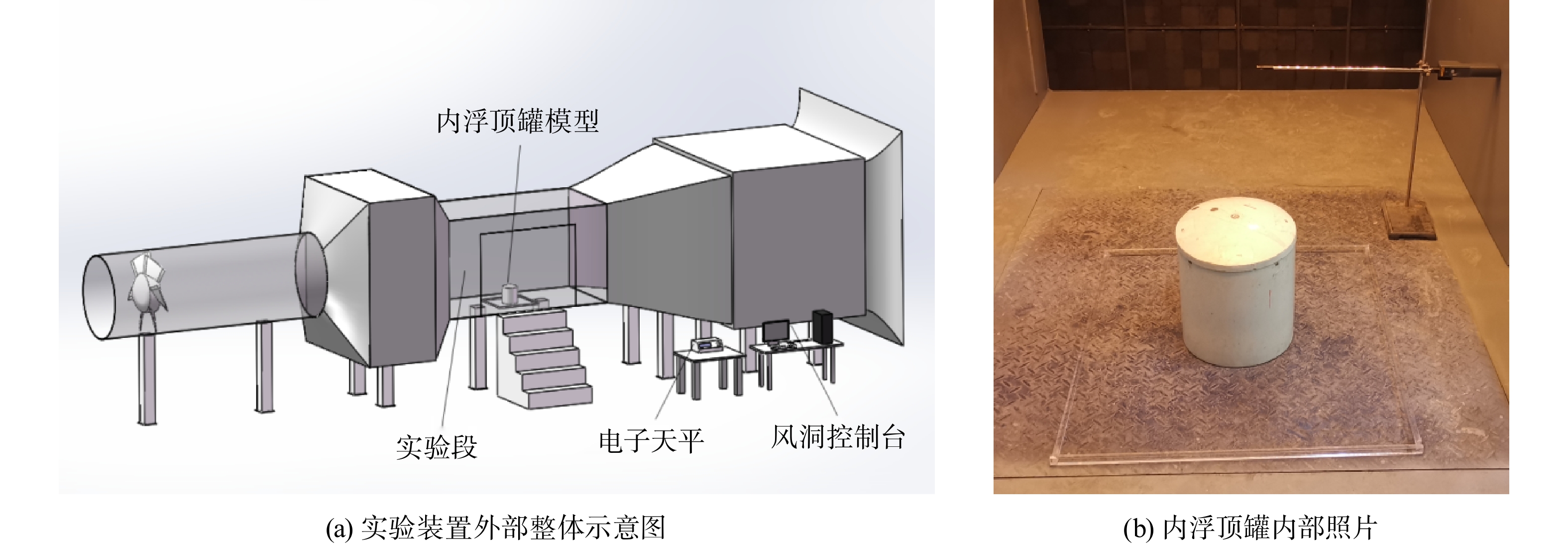
 下载:
下载:
